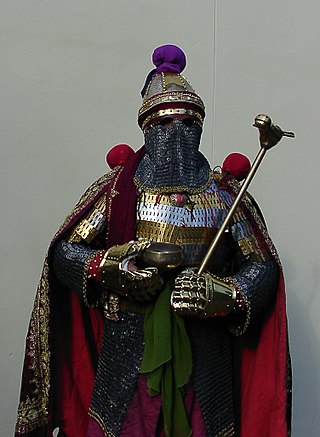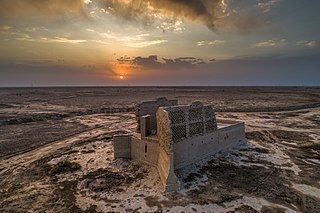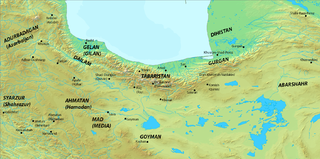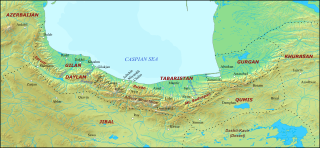Related Research Articles
Sunpadh was an Iranian nobleman from the House of Karen, who incited an uprising against the Abbasid Caliphate in the 8th century.

Bozorgmehr-e Bokhtagan, also known as Burzmihr, Dadmihr and Dadburzmihr, was an Iranian sage and dignitary from the Karen family, who served as minister of the Sasanian king (shah) Kavad I, and the latter's son and successor Khosrow I. He also served as the military commander (spahbed) of Khwarasan under Khosrow I and his successor Hormizd IV. According to Persian and Arabic sources, Bozorgmehr was a man of "exceptional wisdom and sage counsels" and later became a characterisation of the expression. His name appears in several important works in Persian literature, most notably in the Shahnameh. The historian Arthur Christensen has suggested that Bozorgmehr was the same person as Borzuya, but historiographical studies of post-Sasanian Persian literature, as well as linguistic analysis shows otherwise. However, the word "Borzuya" can sometimes be considered a shortened form of Bozorgmehr.

Spāhbed is a Middle Persian title meaning "army chief" used chiefly in the Sasanian Empire. Originally there was a single spāhbed, called the Ērān-spāhbed, who functioned as the generalissimo of the Sasanian army. From the time of Khosrow I on, the office was split in four, with a spāhbed for each of the cardinal directions. After the Muslim conquest of Persia, the spāhbed of the East managed to retain his authority over the inaccessible mountainous region of Tabaristan on the southern shore of the Caspian Sea, where the title, often in its Islamic form ispahbadh, survived as a regnal title until the Mongol conquests of the 13th century. An equivalent title of Persian origin, ispahsālār or sipahsālār, gained great currency across the Muslim world in the 10th–15th centuries.

Sakastan was a Sasanian province in Late Antiquity, that lay within the kust of Nemroz. The province bordered Kirman in the west, Spahan in the north west, Kushanshahr in the north east, and Turan in the south east. The governor of the province held the title of marzban. The governor also held the title of "Sakanshah" until the title was abolished in ca. 459/60.

Sistān, also known as Sakastān and Sijistan, is a historical region in present-day south-western Afghanistan and south-eastern Iran. Largely desert, the region is bisected by the Helmand River, the largest river in Afghanistan, which empties into the Hamun Lake that forms part of the border between Iran and Afghanistan.

The Bavand dynasty, or simply the Bavandids, was an Iranian dynasty that ruled in parts of Tabaristan in what is now northern Iran from 651 until 1349, alternating between outright independence and submission as vassals to more powerful regional rulers. They ruled for 698 years, which is the second longest dynasty of Iran after the Baduspanids.

Abarshahr or Nishapur was a Sasanian satrapy (province) in Late Antiquity, that lay within the kust of Khorasan. The province bordered Media in the west, Hyrcania in the north west, Margiana in the north east, and Harev in the south east. The governor of Abarshahr is attested to have held the unique title of kanarang, distinguished from the title of marzban given to governors of frontier provinces. Abarshahr came to be known as one of the nicknames of the city of Nishapur which was considered to be the capital city of the province of Abarshahr during the Sassanian period and later on.

Tabaristan or Tabarestan, was a mountainous region located on the Caspian coast of northern Iran. It corresponded to the present-day province of Mazandaran, which became the predominant name of the area from the 11th-century onwards.

Padishkhwārgar was a Sasanian province in Late Antiquity, which almost corresponded to the present-day provinces of Mazandaran and Gilan. The province bordered Adurbadagan and Balasagan in the west, Gurgan in the east, and Spahan in south. The main cities of the province were Amol and Chalus.
Farrukhzad was an Iranian aristocrat from the House of Ispahbudhan and the founder of the Bavand dynasty, ruling from 651 to 665. Originally a powerful servant of the Sasanian king Khosrow II, he, along with several other powerful aristocrats made a conspiracy against the latter and ended his tyrannical rule. They thereafter put Khosrow's son Kavadh II on the throne, whose rule lasted only a few months, before he was killed by a plague, being succeeded by his son Ardashir III, who was only after one year murdered by the rebellious former Sasanian army chief (spahbed) Shahrbaraz, who usurped the throne.

The kanārang was a unique title in the Sasanian military, given to the commander of the Sasanian Empire's northeasternmost frontier province, Abarshahr. In Byzantine sources, it is rendered as chanaranges and often used, for instance by Procopius, in lieu of the holder's actual name.

The Dabuyid dynasty, or Gaubarid dynasty, was a Zoroastrian Iranian dynasty that started in the first half of the 7th century as an independent group of rulers that ruled over Tabaristan and parts of western Khorasan. Dabuyid rule over Tabaristan and Khorasan lasted from around 642 to the Abbasid conquest in 760.
The Zarmihrid dynasty was a local dynasty of Tabaristan which ruled over parts of the mountainous areas of the region, from the reign of Sasanian king Khosrau I to 785.

The Masmughans of Damavand were a local dynasty, which ruled Damavand and its surrounding areas from ca. 651 to 760. The founder of the dynasty was a Karenid named Mardanshah of Damavand.
Burzin Shah, also known by the Arabicized form of Barzan Jah, was an Iranian nobleman from the House of Karen. A descendant of Sukhra, he was the governor of Nishapur during the reign of the Sasanian king Yazdegerd III.
The Battle of Nishapur was fought in 652 between the Karen family and the Rashidun Caliphate along with their allies, the Kanārangīyān family.
The Battle of Badghis was fought in 654 between the Karen family and their Hephthalite allies against the Rashidun Caliphate.
Kanadbak, also known as Kanara, was an Iranian nobleman, who was the kanarang during the reign of the Sasanian king Khosrau II, and various other Sasanian monarchs, which includes Yazdegerd III, the last Sasanian king.
Surkhab I was the second ruler of the Bavand dynasty from ca. 673 to 717.
Valash, was an Iranian prince from the House of Karen, who later became the ruler of Tabaristan in 665.
References
- ↑ Pourshariati (2008), pp. 253
- ↑ "Maṣmug̲h̲an." Encyclopaedia of Islam, Second Edition. Edited by: P. Bearman, Th. Bianquis, C.E. Bosworth, E. van Donzel, W.P. Heinrichs. Brill Online, 2013. Reference. 30 November 2013 <http://referenceworks.brillonline.com/entries/encyclopaedia-of-islam-2/masmughan-COM_0702>